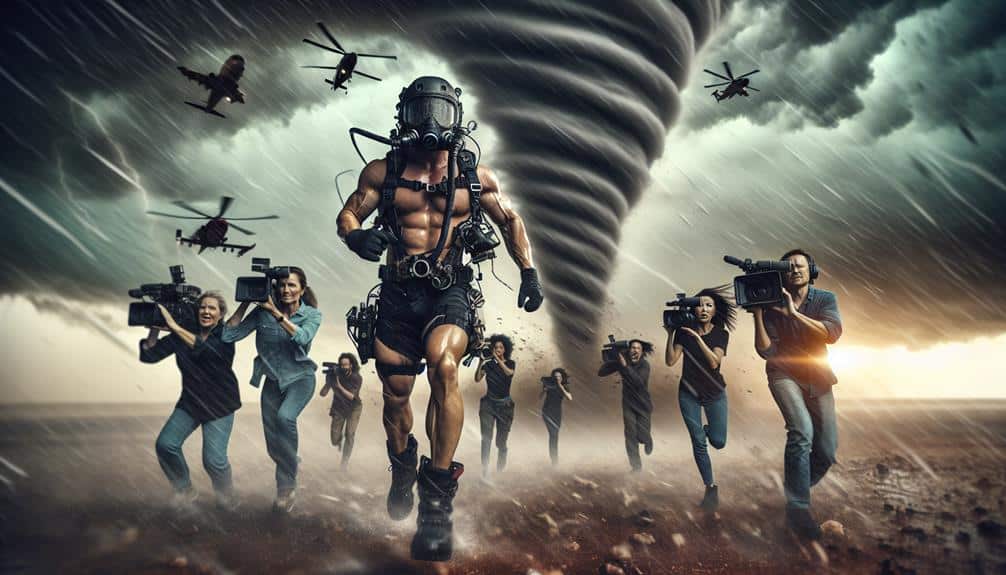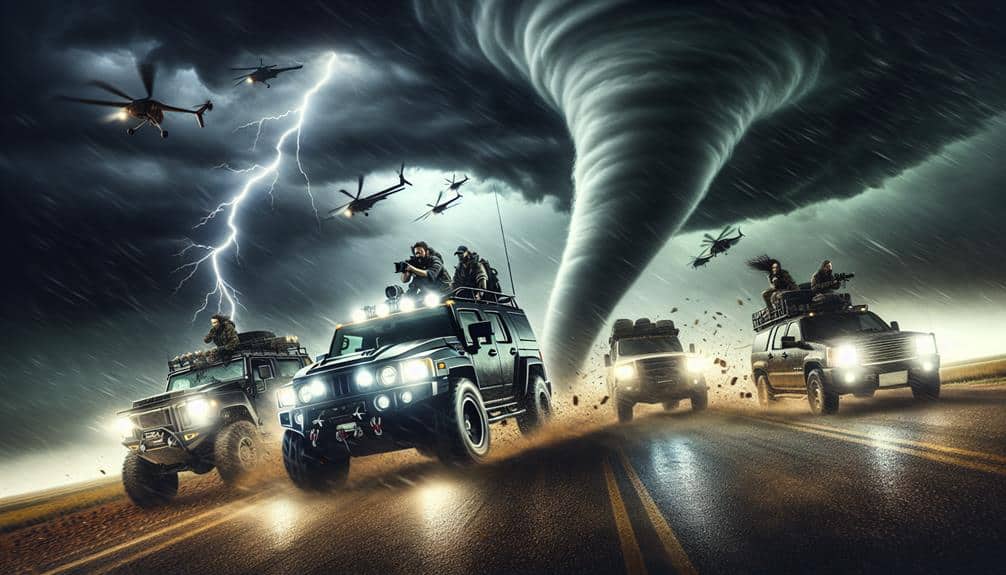We've noticed that media significantly shapes storm chasing culture in several key ways. Technological advancements in media enhance public awareness and make storm chasing more accessible through live broadcasts and educational content. Documentaries offer engaging, in-depth views that bridge science and public interest. Social media revolutionizes content distribution, making storm stories viral and interesting. Enhanced communication tools advance safety practices and collaboration with meteorological agencies. Finally, celebrity storm chasers attract attention, promoting scientific advocacy and public engagement. For a deeper understanding of how these elements interact and influence storm chasing, it is crucial to explore the mechanisms behind them.
Key Points
- Increased media coverage expands public interest and awareness of storm chasing.
- Documentaries with cinematic storytelling create an immersive and educational experience.
- Social media platforms enable viral distribution and real-time engagement with storm chasing content.
- Live broadcasts offer unprecedented access to storm chasing events, enhancing public understanding.
Increased Public Awareness
Advancements in media technology have greatly increased public awareness of storm chasing, providing real-time updates and detailed scientific information. As media coverage has expanded, we've seen a significant rise in public interest in storm chasing activities. Television specials and educational programs have played a pivotal role in demystifying the science behind severe weather phenomena.
Through live broadcasts and dedicated segments, media outlets offer viewers unprecedented access to the frontlines of storm chasing. High-definition footage and expert commentary give us insights into the complexities of tornado formation, hurricane tracking, and thunderstorm dynamics. This not only educates but empowers the public with knowledge on weather safety and preparedness.
Educational programs have leveraged this media evolution to offer structured, data-driven content. These programs often feature meteorologists and storm chasers explaining the science in accessible terms, thereby fostering a deeper understanding of atmospheric conditions. For instance, detailed breakdowns of storm cell structures and wind patterns have become commonplace, thanks to enhanced media dissemination.
Popularization Through Documentaries
Building on the heightened public interest generated by real-time media coverage, documentaries have played a significant role in popularizing storm chasing by offering in-depth explorations and compelling narratives. Through cinematic storytelling and visual impact, these documentaries capture the raw power of nature, which enthralls audiences and fuels a cultural fascination with extreme weather phenomena.
We see that modern documentaries utilize advanced storytelling techniques to provide a thorough understanding of storm chasing. Detailed meteorological data, expert interviews, and high-resolution footage create an immersive experience. These elements combine to portray not just the science behind storm formation and behavior, but also the human element—the passion, dedication, and sometimes peril faced by those who chase these storms.
The visual impact of high-definition images of tornadoes, hurricanes, and other severe weather events captivates viewers, making the science accessible and engaging. As a result, the cultural fascination with storm chasing grows, inspiring a new generation of meteorologists and thrill-seekers alike. Documentaries consequently serve as a bridge between scientific inquiry and public engagement, reinforcing the allure of storm chasing while promoting a deeper appreciation for the complexities of our natural world.
Influence of Social Media
Social media platforms have revolutionized the distribution of storm chasing content, enabling real-time updates and widespread public engagement. By leveraging viral videos, we observe a dramatic increase in viewer engagement and information sharing. These platforms facilitate a dynamic exchange of data, fostering robust online communities of storm enthusiasts and professionals alike. The real-time nature of social media allows for immediate distribution of storm activity, aiding in both public awareness and scientific observation.
Influencer partnerships have further amplified the reach and impact of storm chasing content. Collaborations with popular social media influencers enable us to tap into diverse audiences, expanding the scope of engagement. These influencers, often equipped with high-quality cameras and a talent for engaging storytelling, guarantee that storm chasing content not only informs but also entertains.
Algorithm changes on social media platforms greatly impact the visibility of storm chasing content. By optimizing our posts to align with current algorithms, we can maximize engagement and reach. This strategic approach ensures that our content remains relevant and consistently reaches a larger audience.
Consequently, the intersection of storm chasing and social media has created a lively, interactive, and educational ecosystem.
Impact on Safety Practices
The integration of real-time data from storm chasers into meteorological models has greatly enhanced safety protocols and emergency response strategies. By leveraging high-resolution data, we can more accurately predict storm paths, intensity, and potential impact zones. This precise information aids in risk management, allowing us to allocate resources more efficiently and minimize potential harm.
Our community of storm chasers contributes invaluable data that aids meteorologists in refining predictive models. As a result, emergency response teams can act swiftly and decisively, issuing timely warnings and executing evacuation plans. This collaboration between storm chasers and meteorological agencies fosters a more proactive approach to severe weather events.
Additionally, advancements in communication technology enable us to share real-time updates with the public, empowering individuals to make informed decisions about their safety. We've seen a noticeable improvement in public awareness and preparedness, reducing the overall risk during severe weather events.
Celebrity Storm Chasers

While our contributions to meteorological safety are undeniable, we've also seen the rise of celebrity storm chasers who've captivated public attention and brought a new dimension to storm chasing culture. These individuals leverage their expertise and media-savvy to become household names, often through TV shows, social media, and live streaming platforms. Their celebrity endorsements have propelled storm chasing into mainstream consciousness, attracting a broader audience and fostering increased fan engagement.
Data from social media analytics reveal that interactions with celebrity storm chasers spike significantly during severe weather events. This not only elevates their profiles but also disseminates important safety information to a wider audience. We've observed that fan engagement doesn't merely consist of passive viewership. Instead, it includes real-time discussions, sharing of safety tips, and active participation in weather awareness campaigns. This dynamic has amplified the educational impact of storm chasing, making meteorological science more accessible.
Moreover, celebrity storm chasers often collaborate with brands and organizations, further extending their reach. These collaborations typically involve promoting safety gear, weather apps, and educational content, thereby merging entertainment with public service. As a result, the culture of storm chasing has evolved, becoming both an educational tool and a form of scientific advocacy.
Frequently Asked Questions
How Has Technology Evolved to Aid Storm Chasers Over the Years?
We've seen technology evolve substantially to aid storm chasers. Satellite tracking offers real-time data, enhancing prediction accuracy. Drone footage provides unprecedented views and data collection. These tools empower us to pursue storms with greater precision and safety.
What Are the Psychological Effects of Storm Chasing on Individuals?
The psychological effects of storm chasing on individuals include an adrenaline rush and mental health impacts. We develop emotional resilience and master fear management while maneuvering extreme weather, balancing the thrill with potential mental health challenges.
Are There Educational Programs Dedicated to Storm Chasing?
Yes, there are educational programs dedicated to storm chasing. These programs provide extensive educational resources and emphasize safety precautions. They're designed for those seeking the thrill of storm chasing while ensuring they're well-prepared and informed.
How Do Storm Chasers Collaborate With Meteorologists and Researchers?
We collaborate with meteorologists and researchers through research partnerships, enhancing data collection. This synergy improves forecast accuracy and safety measures, providing us with the freedom to chase storms more effectively and safely while advancing scientific knowledge.
What Are the Environmental Impacts of Storm Chasing Activities?
Coincidentally, as we pursue the thrill of storm chasing, we must consider the environmental impacts. Our activities can exacerbate climate change and cause ecological disruption, but responsible practices can mitigate these effects and preserve our freedom.


